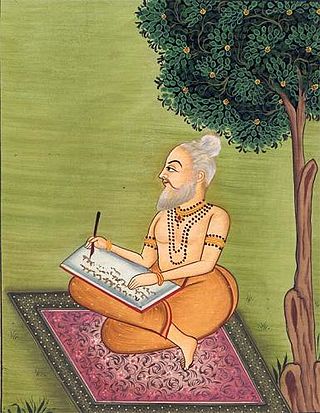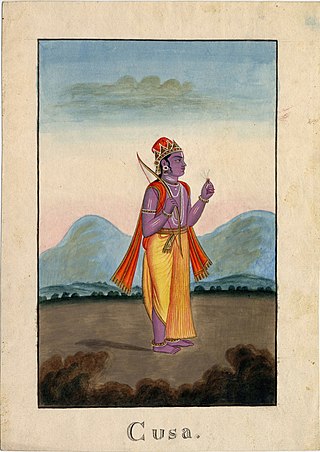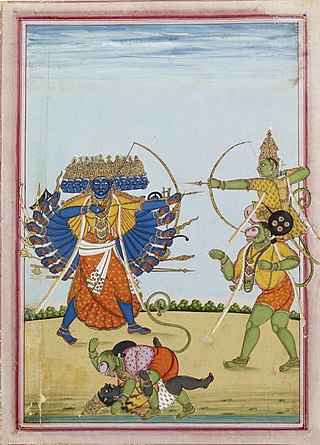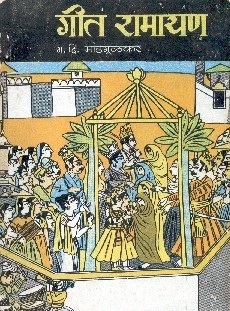
The Ramayana is a smriti text from ancient India, one of the two important epics of Hinduism known as the Itihasas, the other being the Mahabharata. The epic, traditionally ascribed to the Maharishi Valmiki, narrates the life of Rama, a prince of Ayodhya in the kingdom of Kosala. The epic follows his fourteen-year exile to the forest urged by his father King Dasharatha, on the request of Rama's stepmother Kaikeyi; his travels across forests in the Indian subcontinent with his wife Sita and brother Lakshmana; the kidnapping of Sita by Ravana, the king of Lanka, that resulted in war; and Rama's eventual return to Ayodhya along with Sita to be crowned king amidst jubilation and celebration.

Maharishi Valmiki was a legendary poet who is celebrated as the traditional author of the epic Ramayana, based on the attribution in the text itself. He is revered as Ādi Kavi, the first poet, author of Ramayana, the first epic poem.

Sugriva is a character In the ancient Indian epic Ramayana. He is the younger brother of Vali, whom he succeeded as ruler of the vanara kingdom of Kishkindha. Rumā is his wife. He is a son of Surya, the Hindu deity of the sun. As the king of the vanaras, Sugriva aided Rama in his quest to liberate his wife Sita from captivity at the hands of the rakshasa king Ravana.

Lava and his elder twin brother Kusha, are the children of Rama and Sita in Hindu tradition. Their story is recounted in the Hindu epic, Ramayana and its other versions. He is said to have a whitish golden complexion like their mother, while Kusha had a blackish complexion like their father.

Sita, also known as Siya, Janaki, Maithili, Vaidehi and Bhumija, is a Hindu goddess and the female protagonist of the Hindu epic, Ramayana. She is the consort of Rama, the avatar of the god Vishnu, and is regarded as a form of Vishnu's consort, Lakshmi. She is also the chief goddess of Rama-centric Hindu traditions. Sita is known for her dedication, self-sacrifice, courage, and purity.

Kusha and his younger twin brother Lava were the children of Rama and Sita. Their story is recounted in the Hindu epic, the Ramayana. Hindu traditions claim he ruled the entire region of Kashmir, Indus River and Hindu Kush as frontier lands of India known as Hindu Kush Kshetra and founded the city of Kashmir in the valley and Kasur with Lavapuri of Lava in base lands, though local lore contends Kasur was founded in 1525 by Pashtun migrants. His brother Lava is traditionally believed to have founded Lavapuri.

Lava Kusa is a 1963 Indian Hindu mythological film directed by C. S. Rao and his father C. Pullayya. The film was scripted by Sadasivabrahmam, Samudrala Sr. along with C. S. Rao and C. Pullayya. The film was produced by Sankara Reddy under Lalita Sivajyothi Films. Lava Kusa is the first full-length colour film of Telugu cinema.

Ramayana: The Legend of Prince Rama is a 1992 anime film co-produced by Japan and India; produced and directed by Yugo Sako. It is based on the Indian epic Ramayana. The film was directed by Koichi Sasaki and Ram Mohan, with music composed by Vanraj Bhatia. Although it was banned in India during the Babri Masjid riots, it was later dubbed in Hindi and aired on DD National.

Depending on the methods of counting, as many as three hundred versions of the Indian Hindu epic poem, the Ramayana, are known to exist. The oldest version is generally recognized to be the Sanskrit version attributed to the sage Narada, the Mula Ramayana. Narada passed on the knowledge to Valmiki, who authored Valmiki Ramayana, the present oldest available version of Ramayana.

Geet Ramayan is a collection of 56 Marathi language songs chronologically describing events from the Indian Hindu epic, the Ramayana. It was broadcast by All India Radio, Pune in 1955–1956, four years before television was introduced in India. Written by G. D. Madgulkar and the songs being composed by Sudhir Phadke, Geet Ramayan was acclaimed for its lyrics, music and singing. It is considered a "milestone of Marathi light music" and the "most popular" Marathi version of Ramayana.

Bala Kanda is the first Book of the Valmiki Ramayana. The Bala Kanda, in part—if not in its entirety—is generally regarded as an interpolation to the original epic.

Sri Rama Rajyam is a 2011 Indian Telugu-language devotional film directed by Bapu who co-wrote the film with Mullapudi Venkata Ramana, and produced by Yalamanchali Saibabu. The film stars Nandamuri Balakrishna, Nayanthara, Akkineni Nageswara Rao, Srikanth, and its music was composed by Ilaiyaraaja, which won him Nandi Award for Best Music Director. Sri Rama Rajyam is a reboot of the 1963 blockbuster film Lava Kusa.

Kanchana Sita is a 1977 Indian Malayalam feature-length film scripted and directed by G. Aravindan. A mythological film, its story was adapted from C. N. Sreekantan Nair's play of the same name, which is a reworking of Valmiki's Ramayana.
Raghuvaṃśa or Raghukula is a legendary Indian dynasty, primarily featured in Hindu scriptures such as the Itihasas and the Puranas. It is considered to be an offshoot of the Sūryavaṃśa or the Ikshvaku dynasty lineage of kings, tracing its ancestry to the sun deity Surya. Kings of the Raghuvaṃśa line are referred to as Raghuvaṃśī. The dynasty is named after Raghu, a legendary king who protected the sacrificial horse of ashvamedha from Indra. Raghuvaṃśī kings include Mandhata, Harishchandra, Sagara, Bhagiratha, Dilīpa, Raghu, Aja, Dasharatha and Rama.

Ram Rajya is a 1943 Hindi film, directed by Vijay Bhatt, with Prem Adib and Shobhna Samarth in the lead roles of Rama And Sita. It was the third highest grossing Indian film of 1943.

Sons of Ram is a 2012 Indian animated film created by ACK Animation Studios, and co-produced by Maya Digital Studios and Cartoon Network India. Based on Hindu mythology, it depicts the sons of Rama, Luv and Kush. It is Amar Chitra Katha's first animated feature film in stereoscopic 3D. It was released to theatres in India on 2 November 2012.
The SreeSeetha Devi Lava Kusa Temple at Pulpally in Wayanad district has a unique position among the temples of Kerala, for it is the only known temple to have installed deities of Lava and Kusha, children of Sree Rama and Seetha Devi, with active worship continuing. The legend of Sita, and her children Lava and Kusa is closely linked to this temple. It is believed that even the name Pulpally is connected to the bed of grass (Dharbha) on which Lava is believed to have played as a child.

Ram Rajya is an Indian 1967 Hindi religious film based on Valmiki's Ramayana and directed by Vijay Bhatt. The film was produced by Shankarbhai Bhatt. The music director was Vasant Desai with lyrics written by Bharat Vyas. The cinematographer was Pravin Bhatt and the film starred Bina Rai, Kumar Sen, Badri Prasad, Kanhaiyalal, Farida dadi, Anil Kumar, Jay Vijay.

Lav Kush is a 1997 Indian Hindu mythological film, produced by Dilip Kanikaria under the Devyank Arts banner and directed by V. Madhusudhana Rao. It is based on Valmiki's Uttar Ramayan from the Indian epic Ramayana. The music of the film was composed by Raamlaxman. It stars Jeetendra as Rama, Jaya Prada as Sita, Arun Govil as Lakshmana, Dara Singh as Hanuman and Pran as Valmiki.

Ramayan is a Hindi TV series that was aired on Zee TV in 2001. It is a television adaptation of the ancient Indian epic of the same name, and is primarily based on Valmiki's Ramayana, Tulsidas Ramcharitramanas, Kalidasa's Raghuvaṃśa and Kambar's Kambh Ramayana. It was produced and directed by Baldev Raj Chopra and Ravi Chopra.

















